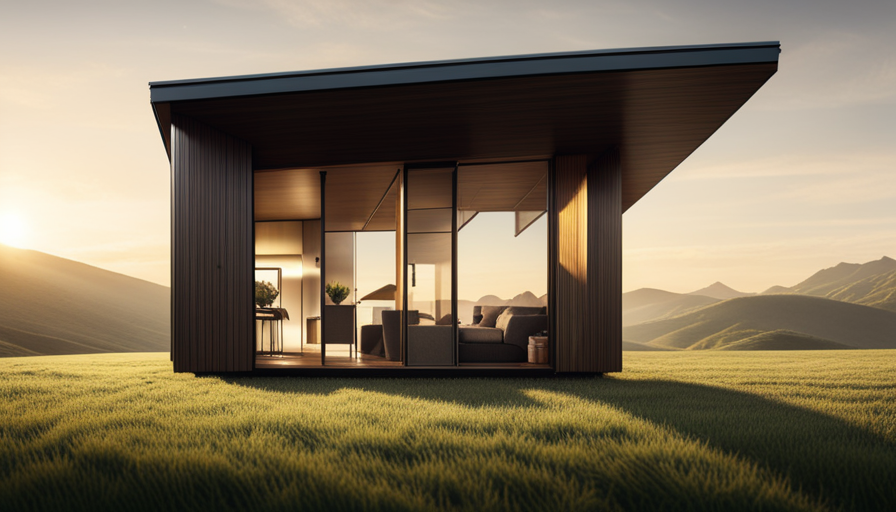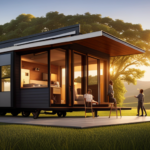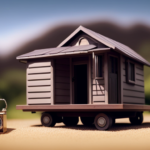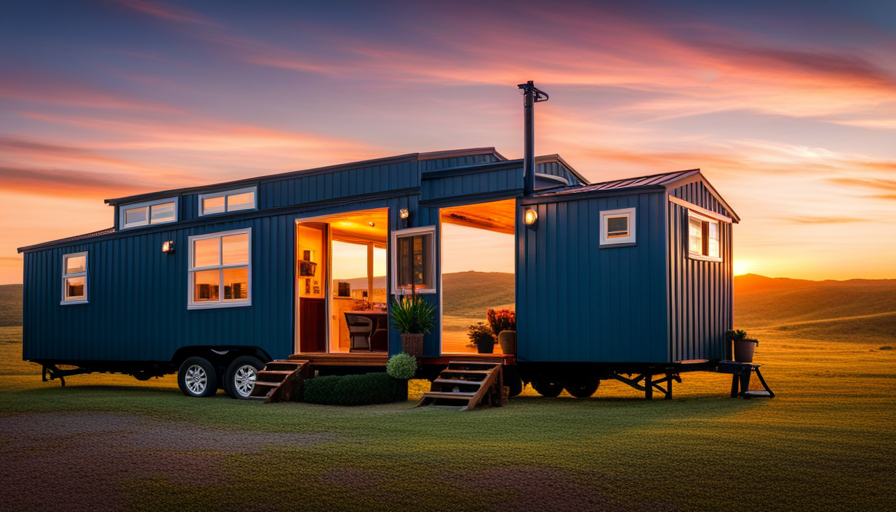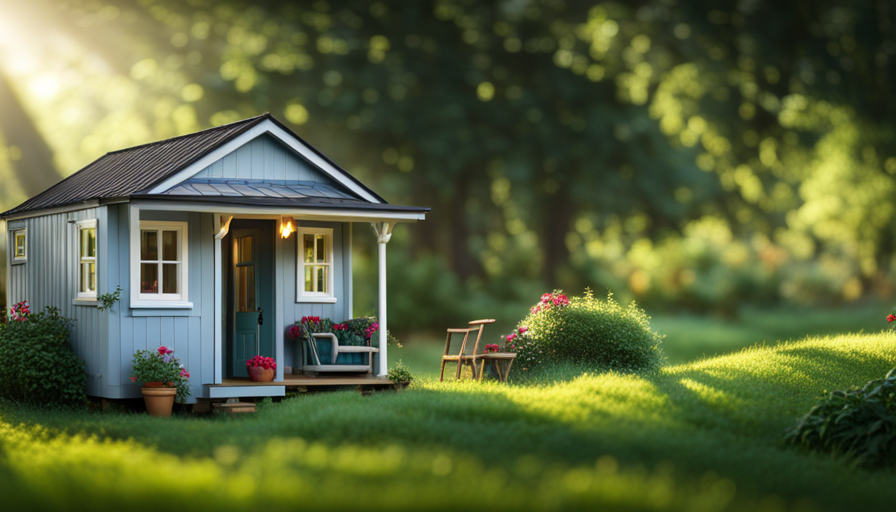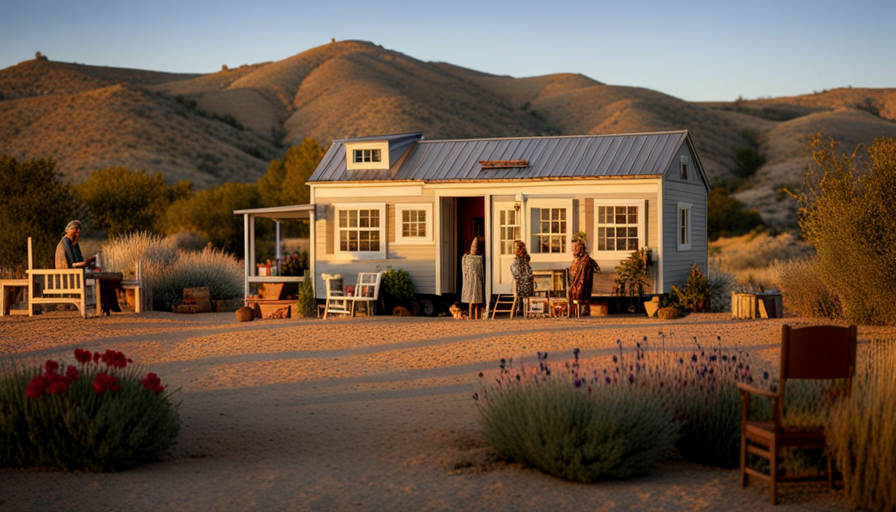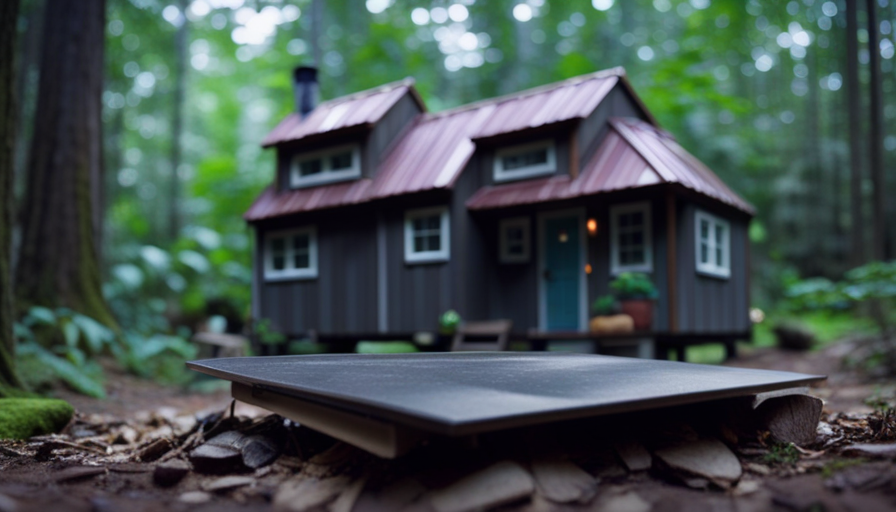Embarking on the exciting journey of building a tiny house involves carefully considering the principle of weight distribution. This often overlooked aspect of design is crucial for ensuring the structural integrity, comfort, and usability of your small living space.
In this article, I will guide you through the intricacies of weight distribution, offering expert advice on determining maximum weight capacity, planning layouts, choosing lightweight materials, and properly distributing furniture and appliances. We will also explore the weight of utilities and systems, the importance of regular inspections, and the benefits of consulting with professionals.
Furthermore, I will share valuable tips for achieving both mobility and stability in your tiny house, ensuring a safe and enjoyable living experience. So, let’s dive into the world of weight balancing and unlock the secrets to designing your dream tiny house.
Key Takeaways
- Weight distribution is crucial for structural integrity and comfort in tiny house design.
- Lightweight materials and insulation options should be chosen for construction to minimize overall weight.
- Furniture and appliances should be strategically placed for even weight distribution and functionality.
- Vertical space and built-in storage should be utilized for efficient storage solutions.
Understanding the Importance of Weight Distribution
You don’t want to overlook the significance of weight distribution in your tiny house design, as it can greatly impact the stability and functionality of your living space. Calculating load bearing capacity is an essential step in ensuring that your tiny house can support the weight it will bear.
This involves determining the maximum weight that each component of your house, such as the walls, roof, and foundation, can handle. By distributing the weight evenly across these components, you can prevent any one area from becoming overloaded and potentially causing structural damage.
In addition to stability, weight distribution also affects the mobility of your tiny house. If the weight is not properly balanced, it can lead to difficulties when towing or moving your tiny house. Uneven weight distribution can cause excessive strain on the axles, tires, and suspension system, making it harder to maneuver.
By strategically placing heavier items near the center of the house and taking into account the impact of weight on mobility, you can ensure a smoother and safer travel experience.
Determining the maximum weight capacity of your tiny house is the next crucial step in the design process.
Determining the Maximum Weight Capacity of Your Tiny House
To ensure your tiny abode can handle the load, it’s crucial to figure out the maximum weight your compact dwelling can withstand. Determining the weight capacity of your tiny house is a complex task that requires careful calculations and considerations. Here are three important factors to help you determine the maximum weight capacity of your tiny house:
-
Structural Integrity: Start by assessing the strength and durability of your tiny house’s foundation and framing. Consult with a structural engineer to ensure that your foundation can support the weight of your house and all its contents.
-
Weight of Belongings: Calculate the total weight of your belongings, including furniture, appliances, and personal items. Consider the weight of water, propane tanks, and any other supplies that will be stored in the house. This will give you an idea of the load your tiny house needs to bear.
-
Safety Margins: It’s essential to leave some safety margins when determining the weight capacity of your tiny house. Consider adding an additional 20% to the calculated weight to account for unexpected loads or changes in usage over time.
By accurately determining the maximum weight capacity of your tiny house and considering these factors, you can ensure that your compact dwelling is structurally sound and can handle the weight of your belongings. Planning the layout to achieve balanced weight distribution is the next crucial step in creating a safe and functional tiny house.
Planning the Layout to Achieve Balanced Weight Distribution
Creating a well-balanced layout is crucial for ensuring the structural integrity and stability of your compact dwelling. Achieving visual appeal and incorporating storage solutions are key factors to consider when planning the layout of your tiny house. By strategically placing furniture and storage units, you can distribute the weight evenly throughout the space.
To help you visualize the layout, here is a table that outlines some ideas for achieving balanced weight distribution in a tiny house:
| Area | Weight Distribution Ideas |
|---|---|
| Living Room | Place furniture symmetrically for visual balance. |
| Kitchen | Utilize upper and lower cabinets for storage. |
| Bedroom | Install built-in closets for organized storage. |
| Bathroom | Use wall-mounted shelves for toiletries. |
| Loft | Position bed and storage on opposite sides. |
| Outdoor Space | Store heavy items in a shed or storage unit. |
By following these ideas, you can maintain a harmonious balance of weight throughout your tiny house while achieving visual appeal and incorporating storage solutions. This balanced layout will lay the foundation for the subsequent step of choosing lightweight materials for construction.
Choosing Lightweight Materials for Construction
When it comes to constructing your compact dwelling, opting for lightweight materials is essential in ensuring a strong and durable structure that doesn’t compromise on space or functionality.
One of the key considerations is choosing lightweight insulation options that provide excellent thermal performance without adding unnecessary weight to the overall structure. Materials like expanded polystyrene (EPS) foam or fiberglass insulation can significantly reduce the load on your tiny house while still effectively insulating it from heat and cold.
In addition to insulation, using recycled materials can offer several benefits when it comes to weight distribution in your tiny house. Recycled materials, such as reclaimed wood or recycled metal, are often lighter than their newly manufactured counterparts. Not only does this contribute to a lighter overall weight of the structure, but it also promotes sustainability by reducing the demand for new resources.
By incorporating lightweight insulation options and utilizing recycled materials, you can achieve a well-balanced weight distribution in your tiny house. This ensures that the structure remains sturdy and durable while maximizing the available space for furniture and appliances.
Speaking of furniture and appliances, the next step is to properly distribute them to maintain balance and functionality throughout the tiny house.
Properly Distributing Furniture and Appliances
Ensure that you strategically arrange your furniture and appliances in your compact dwelling to maintain an optimal balance and functionality throughout the space. When designing a tiny house, efficient storage solutions and multi-purpose furniture are essential to make the most of limited square footage.
Here are four key strategies to properly distribute your furniture and appliances:
-
Utilize vertical space: Install shelves and wall-mounted storage units to maximize storage capacity without taking up valuable floor space. This allows you to keep your belongings organized and easily accessible.
-
Opt for furniture with built-in storage: Choose sofas, beds, and tables that have hidden compartments or drawers. This not only provides extra storage but also reduces clutter and keeps your living area tidy.
-
Consider foldable and expandable furniture: Invest in pieces that can be easily folded or expanded when needed. For example, a folding dining table can be tucked away when not in use, creating more space for other activities.
-
Use furniture with multiple functions: Look for items that serve multiple purposes. A sleeper sofa, for instance, can be used as a comfortable seating area during the day and then transformed into a bed at night.
By efficiently organizing your furniture and utilizing multi-purpose pieces, you can create a compact living space that feels spacious and functional.
In the subsequent section about installing reinforcements for structural integrity, we’ll explore another crucial aspect of balancing weight in your tiny house design.
Installing Reinforcements for Structural Integrity
When it comes to properly distributing furniture and appliances within a tiny house, one must also consider the structural integrity of the overall design. In order to ensure that the weight is balanced and properly supported, it’s important to install reinforcements for the foundation. This involves using adjustable support systems that can be customized to fit the specific needs of the tiny house.
Reinforcing the foundation is crucial because it provides stability and prevents any potential damage caused by uneven weight distribution. By using adjustable support systems, you can easily adjust the height and level of the foundation to accommodate the weight of the furniture and appliances.
These support systems are designed to evenly distribute the load and provide additional strength to the structure. They can be adjusted as needed, allowing for flexibility in the overall design. This ensures that the weight is properly balanced and reduces the risk of any structural issues in the future.
Transitioning into the next section about considering the weight of utilities and systems, it’s important to not only focus on the furniture and appliances, but also on the additional weight that comes from the various utilities and systems within the tiny house.
Considering the Weight of Utilities and Systems
To truly optimize your tiny home experience, it’s essential to take into account the added load from utilities and systems. Considering the weight of plumbing and sewage systems is crucial when balancing weight in your tiny house. These systems can add significant weight, especially when considering the water storage tanks, pipes, and fixtures.
It is important to evaluate the impact of electrical systems on weight distribution as well. While electrical components may not be as heavy as plumbing systems, they can still contribute to the overall weight of the house. This includes wiring, outlets, switches, and appliances.
When designing a tiny house, it’s important to carefully plan the layout and placement of these systems to evenly distribute the weight. For example, placing the water storage tanks near the center of the house can help balance the load and prevent any potential structural issues. Similarly, distributing electrical components evenly throughout the house can help maintain weight distribution.
By considering the weight of utilities and systems, you can ensure that your tiny house is structurally sound and safe to live in. Regularly inspecting and maintaining weight distribution will be discussed in the subsequent section, ensuring that your tiny house remains in optimal condition.
Regularly Inspecting and Maintaining Weight Distribution
Regularly inspecting and maintaining weight distribution is like tending to a delicate ecosystem, ensuring its longevity and stability.
Regular inspections of weight distribution are of utmost importance to maintain the structural integrity of your tiny house. By following a few techniques, you can ensure that the weight is evenly distributed, preventing any potential issues.
Here are two sub-lists that highlight the importance of regular inspections and techniques for maintaining weight distribution:
Importance of regular inspections:
- Identify any signs of imbalance or stress on the structure
- Catch potential problems before they become major issues
Techniques for maintaining weight distribution:
- Use leveling jacks to adjust the height and balance of your tiny house
- Periodically shift furniture and belongings to distribute weight evenly
Regularly inspecting and maintaining weight distribution will help you avoid structural problems and ensure the longevity of your tiny house. By taking these steps, you can create a safe and stable living environment.
Transitioning into the subsequent section about consulting with a professional for expert advice, it’s essential to seek guidance from a knowledgeable individual. They can provide valuable insights and recommendations to optimize weight distribution in your tiny house.
Consulting with a Professional for Expert Advice
It’s important to seek guidance from a knowledgeable professional who can provide valuable insights and recommendations for optimizing the distribution of weight in your compact living space. Consulting with a professional can help you explore alternative approaches and cost-effective solutions to ensure that your tiny house remains structurally sound and well-balanced.
A professional can analyze your design plans and offer suggestions on how to distribute weight efficiently throughout your tiny house. They can help you determine the best placement of heavy furniture, appliances, and storage areas to maintain stability and prevent any potential issues in the future. Additionally, they can guide you in selecting appropriate materials that are lightweight yet durable, minimizing the overall weight of your tiny house.
By consulting with a professional, you can also learn about innovative techniques and strategies for weight distribution. They may suggest creative solutions such as using lightweight materials for the walls or incorporating built-in storage options that optimize space while keeping the weight evenly distributed.
Seeking expert advice will ensure that you make informed decisions regarding weight distribution in your tiny house. With their help, you can achieve optimal balance and stability while keeping costs in check.
Transitioning into the subsequent section about tips for achieving mobility and stability in your tiny house, it’s essential to consider these factors when designing your compact living space.
Tips for Achieving Mobility and Stability in Your Tiny House
Creating a compact living space that’s both mobile and stable can be achieved by carefully considering mobility and stability factors in your tiny abode. To help you achieve this, here are some tips for maximizing space efficiency and incorporating clever storage solutions:
-
Utilize Vertical Space: Take advantage of every inch of your tiny house by utilizing vertical space. Install tall cabinets and shelves to store items, and consider using hanging storage solutions for things like pots and pans.
-
Multifunctional Furniture: Opt for furniture pieces that serve multiple purposes. For example, a sofa that can also be converted into a bed or a coffee table that doubles as a storage unit. This will help you save space while still having all the necessary furniture in your tiny house.
-
Hidden Storage: Look for hidden storage opportunities in unexpected places. Consider installing storage compartments under your stairs, utilizing the space beneath your bed, or incorporating storage solutions into your walls.
-
Foldable and Collapsible Items: Invest in foldable or collapsible items such as tables, chairs, and even kitchen appliances. These can be easily stored away when not in use, allowing you to maximize space efficiency.
-
Organizational Systems: Implement organizational systems throughout your tiny house. Use bins, baskets, and dividers to keep your belongings organized and easily accessible. This will help you make the most of your limited space while keeping everything in its place.
By following these tips, you can achieve both mobility and stability in your tiny house while maximizing space efficiency and incorporating clever storage solutions.
Frequently Asked Questions
What are some common lightweight materials used in the construction of tiny houses?
Lightweight insulation and sustainable building materials are crucial in constructing tiny houses. Some common lightweight materials include rigid foam insulation, aerated concrete blocks, and lightweight steel frames. These materials ensure structural integrity while reducing overall weight.
How often should weight distribution be inspected and maintained in a tiny house?
Regular weight inspections are crucial for maintaining structural integrity. Maintaining proper weight distribution in a tiny house poses challenges like limited space and varying load requirements. Neglecting inspections can lead to structural issues and compromise safety.
Are there any specific guidelines for properly distributing furniture and appliances in a tiny house?
Proper weight distribution techniques in tiny house design involve efficient organization of furniture and appliances in a compact living space. By strategically placing heavier items near the center and using lightweight materials, stability and functionality can be maximized.
What are some potential consequences of unbalanced weight distribution in a tiny house?
Unbalanced weight distribution in a tiny house can lead to potential structural damage and decreased mobility. Excessive weight on one side can cause the house to tilt, while concentrated weight can strain the foundation and overall stability.
Can a tiny house be modified to increase its maximum weight capacity?
To increase the weight capacity of a tiny house, one can modify its structural elements. For example, reinforcing the foundation, using stronger materials, and redistributing weight can improve the overall structural integrity and support heavier loads.
Conclusion
In conclusion, achieving a balanced weight distribution in a tiny house is crucial for both mobility and stability. By carefully planning the layout, choosing lightweight materials, and properly distributing furniture and appliances, you can ensure that your tiny house remains structurally sound.
Regular inspections and maintenance are also essential to prevent any weight imbalances over time. Remember, it’s not just about creating a functional living space, but also about enjoying the freedom and flexibility that comes with living in a tiny house.
So go ahead, embark on this unique adventure and let your creativity soar!
Hi, I’m Emma. I’m the Editor in Chief of Tiny House 43, a blog all about tiny houses. While tree houses are often associated with childhood, they can be the perfect adult retreat. They offer a cozy space to relax and unwind, surrounded by nature. And since they’re typically built on stilts or raised platforms, they offer stunning views that traditional homes simply can’t match. If you’re looking for a unique and romantic getaway, a tree house tiny house might just be the perfect option.
